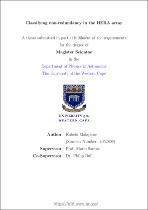| dc.contributor.advisor | Santos, Mario | |
| dc.contributor.author | Malapane, Kabelo | |
| dc.date.accessioned | 2022-09-16T11:27:25Z | |
| dc.date.available | 2022-09-16T11:27:25Z | |
| dc.date.issued | 2022 | |
| dc.identifier.uri | http://hdl.handle.net/11394/9306 | |
| dc.description | >Magister Scientiae - MSc | en_US |
| dc.description.abstract | HERA is a highly redundant radio interferometer array, where pairs of receivers
with the same position vector between them should see exactly the same signal
from the sky. We can use this fact to do a really good job of calibrating them.
Unfortunately, the receivers are not perfectly identical, and so they don’t see exactly
the same signal. This is called "non-redundancy". This project classifies the level of
redundancy using a clustering machine learning technique. The aim is to see if any
particular clustering algorithm can group different segments of the array into very
similar blocks, so we can at least do a good job of redundantly calibrating within
those blocks. We call this new calibration method, logi_cal, while the standard
calibration method used in HERA is called redcal. | en_US |
| dc.language.iso | en | en_US |
| dc.publisher | University of the Western Cape | en_US |
| dc.subject | Low frequency arrays | en_US |
| dc.subject | Clustering | en_US |
| dc.subject | Radio telescope | en_US |
| dc.subject | Astronomy | en_US |
| dc.subject | Astrophysics | en_US |
| dc.title | Classifying non-redundancy in the HERA array | en_US |
| dc.rights.holder | University of the Western Cape | en_US |

